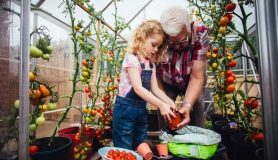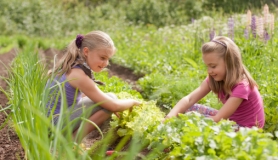ANDY HAMILTON, founder of selfsufficientish.com and author of The Self-Sufficient Bible has plenty of advice on making the most of a small plot.
“There are plenty of spaces in and around the house that we often forget about – the less obvious areas where, with a bit of imagination, you could consider growing vegetables. Once you’re determined to grow your own, you’ll discover you start thinking quite differently about your living space – the container full of cooking utensils will find a new home as you squeeze basil and chilli plants onto the sunny window ledge in the kitchen and the fire escape at the back of your flat now seems like the perfect place to grow tomatoes. As well as being an inexpensive way of producing organic food, growing your own vegetables will bring cheer to even the gloomiest of places – there are few people who wouldn’t rather see a bee pollinating their home grown beans than a grey, lifeless patch of concrete. If you’re fortunate enough to own a porch, make the most of it by growing fruit and vegetables there: in the height of summer, a porch can be hotter than many purpose-built greenhouses. Every year we start our seedlings off on all the available windowsills in our house. To germinate, seeds need to be fooled into believing that the soil is warming up and the sunlight is returning, just as it would outside in spring. Ideally place a table in front of the windowsill so that you have space for a number of seed trays.”
Easy Balcony Gardening
With planning, a small balcony can offer some of the same amenities as a garden in the ground: lush foliage, colorful flowers - even fruit and vegetables. A balcony offers a host of gardening challenges - no soil, perhaps too much shade or too much sun, and difficulty in bringing water to the garden. Don’t give up your gardening dreams, however. You can grow a balcony garden if you keep the following in mind:
- Create a focal point. For example a dwarf fruit tree could be trained on cordons against the wall.
- Use window boxes. Fasten window boxes to your balcony’s railing, so that they’re visible from in and outside. Use these to grow edible leaves and flowers.
- Grow container plants like tomatoes, cucumbers and peppers in lightweight containers.
- Go vertical and train climbers, such as cucumbers and tomatoes up the walls or against the railings.
- Recycle water. Use waste water from baths and washing up to water the plants on your balcony.
JOHN SEYMOUR was an influential figure in the self-sufficiency movement. A polymath, he wrote several books and cared deeply about the planet Earth and the health of the soil. “’Small is beautiful’ is Dr. Schumacher’s famous phrase and a small garden can be quite as beautiful – and if it’s intensively cultivated, almost as productive – as a large one,” John enthuses. “In fact, it’s often much easier to practise intensive gardening methods in a small garden: for example a sackful of leaf mould gathered from a nearby park will make a significant difference to the fertility of a small garden, while you would need a lot more for it to be effective in a large one. You must learn to make use of every available bit of growing space – and there are many more possibilities than you might think. Garden fences, posts and walls all provide vertical growing space. You can also grow down from a height by using hanging tubs. A patio is a useful space for tubs, containers or growbags. Broad beans, runner beans, broccoli, cabbage, summer lettuce and cucumbers will all grow well on a patio.”
PIPPA GREENWOOD uses the space effectively in her kitchen garden in Hampshire. “To make use of every scrap of space when drawing up a plan of what to grow where, try intercropping. This may sound complicated but nothing could be simpler. All it means is that you sow or plant a fast growing, fast maturing crop, such as lettuce between a slow growing, slow maturing crop, such as parsnips. The first crop will be harvested long before the slower growing one needs the space to itself. I even raised an early crop of lettuce in between a row of extra early potatoes under a mini polytunnel.”
Vertical Gardening
Growing plants against a wall, which provides support for climbers is a clever way to maximize use of space. Fruit can be trained as espaliers, cordons or in a fan shape and tied with wire. Some vegetables can also be trained to grow up a vertical surface – think peas, cucumbers, runner beans and squash. Walls are particularly good for growing tender plants that require a more sheltered environment as the wall absorbs heat from the sun during the day and releases it at night. The other benefit to vertical gardening is that it looks great.
MADDY HARLAND is editor of Permaculture Magazine - permaculture.co.uk. She has been working on her own permaculture garden for nearly 20 years and it is her pride and joy! “In the 1970s, Australians, Bill Mollinson and David Holmgren observed how their ancient Antipodean landscape was devastated by the imposition of a temperate European agriculture. Their response was to design a ‘permanent agriculture’ with tree crops and other perennials inhabiting all the niches from the canopy to the ground cover and below. Permaculture has evolved into a thinking tool for designing low carbon, highly productive systems; the key is to observe and mirror nature in whatever we chose to design. Small gardens are ideal for permaculture; you can use design principles such as ‘stacking’ – basically using vertical spaces – to grow tasty annual and perennial edibles such as climbing beans and berries as well as espaliered apples on fences and at the back of veggie beds. Ground cover like alpine strawberries are low maintenance and children love foraging for their tasty fruits. Even a small roof area can harvest rainwater, reducing water bills, and compost recycles kitchen waste and waste paper into fertile soil. Pots full of potatoes, culinary herbs and blueberries bushes can be both attractive and productive. Add to this some basic eco-renovation (check out the availability of grants with your local council and at the Energy Saving Trust) and look out for community events like seed swaps and you’ll find you can save money, open your children’s eyes to the natural world and have fun as a family.”
Grow food not lawns
HEATHER FLORES is co-founder of the original Food Not Lawns grassroots garden project in Oregon, USA. See foodnotlawns.net. She is passionate about getting over our obsession with lawns and drawing communities together to garden. “French aristocrats popularized the idea of the green grassy lawn in the eighteenth century when they planted the fields around their estate with grass to send the message that they had more land than they needed and could afford to waste some. Today 58 million Americans spend around $30 billion every year to maintain their lawns, the average size of which is a third of an acre. That same area could have a small patch of recreation lawn and still produce all the vegetables needed to feed a family of six. Lawns are not only a highly inefficient use of space, water and money but are also seriously contributing to the rapid degradation of our natural environment.”
PHILIP TURVIL of horticultural charity, Garden Organic, gardenorganic.co.uk explains no-dig vegetable gardening. “Swap the chore of digging large plots by involving the whole family in spreading organic soil improver over small beds. Firstly, lay down layers of wet cardboard, followed by a mixture of leaf mould, straw, compost and rich organic fertiliser such as chicken manure. Worms will then do the hard work for you, dragging down this ‘mulch’ and incorporating it into the soil to feed crops. The trick is making beds a manageable size so that you can comfortably reach the centre from all sides. This avoids anyone needing to tread on soil to tend crops, helping to minimise soil compaction. The exception to the no-dig method is very compact soil that is worth digging over once before starting no-dig. You can sow and plant crops as usual through the mulch, but try closer planting and more frequent harvests allowed by the more productive soil. April is a good time to start salads, peas, brassicas and maincrop potatoes outdoors.” Read Charles Dowding’s Organic Gardening: The Natural No-Dig Way for more advice.
This article was first published in The Green Parent Issue 34. To read content from all our back issues subscribe to our digital editions and get full access to our archive.







